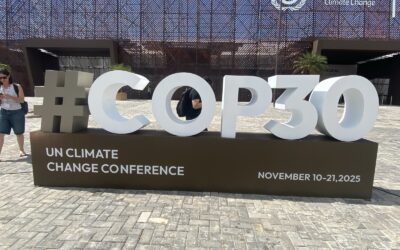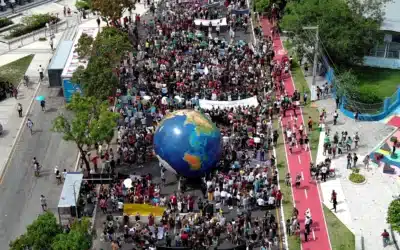
On the occasion of International Day for Biodiversity and the start of UN talks on a possible sustainable development goal (SDG) on agriculture [1], a coalition of environmental NGOs has published a briefing paper to raise awareness of the negative impacts of rapidly expanding industrial livestock farming and large-scale cattle ranching on the world’s forests and biodiversity. Industrial animal agriculture cuts across multiple sectors, affecting land use, water, food security, public health, and climate change. But too often these intersections are overlooked.
The paper, [2] launched today by Brighter Green [3] and the Global Forest Coalition [4], highlights the reality that large-scale cattle ranching and production of feed and fodder for the industrial livestock industry are by far the main causes of forest loss in Latin America, and play significant roles in biodiversity loss in other continents. The global livestock sector is also one of the main contributors to global warming, responsible for no less than 18% of world-wide greenhouse gas emissions.
The paper also features short case studies of how communities from Chad to Indonesia to Argentina are feeling the effects of industrial livestock production on forests, livelihoods, and their land.
“Despite increasing attention to the need to address unsustainable agriculture as a major driver of forest and biodiversity loss and climate change, Governments continue to turn a blind eye to the devastating impacts of modern-day industrial livestock farming,” states Simone Lovera, executive director of the Global Forest Coalition, a global network of NGOs and Indigenous Peoples organization headquartered in Paraguay. “Here in Paraguay, for example, large-scale cattle ranching and the production of soy for the intensive livestock industry destroy more than 850 hectares of forest every day, with devastating impacts on Indigenous Peoples and local communities, including Indigenous Peoples in voluntary isolation.
“The burdens created by the spread of industrialized animal agriculture are wide and varied, spanning ecological, social, and ethical spheres,” adds Mia MacDonald, executive director of Brighter Green. “There is no way hunger and malnutrition can be eradicated, or equity achieved, if we continue to use more than 30 percent of the Earth’s land surface and 70 percent of agricultural land for livestock and feed production.”
The briefing paper also highlights the social and health impacts of industrial livestock farming, including on animal welfare. Each year, more than sixty billion animals are raised for human consumption and more than 98% of soy meal (created by crushing soy beans) is used as feed for farmed animals. Only a generation ago, most chickens in India were raised in backyard flocks, often by women. Now, 90 percent of the more than 2 billion chickens that come to market in India each year have lived their entire lives in industrial-style facilities, and India is the world’s fifth biggest poultry meat producer.
In addition to a loss of connection with nature and deviation away from traditional cultures, the industrialization of the meat industry is amplifying public health issues across the globe. In China, now the world’s largest producer and consumer of animal products, diet-related chronic disease is the most common cause of death.
The paper also explores how more sustainable forms of livestock farming, like traditional pastoralism, are being destroyed through “land grabbing” for feed and fodder production. The authors recommend that the land tenure rights of these pastoralist peoples are protected and that small-scale, ecological forms of agriculture and more balanced diets are supported over industrial meat and feed production.
Government subsidies that now support the expansion of industrial-scale livestock and feed operations should be ended and the “externalities” on which animal agriculture is dependent—such as water pollution, contamination of soil and groundwater, land degradation, and GHGs—should be paid for, in full, by the industry and/or specific facilities that cause them. The authors also call for political openness, especially in policy-making, so that voices questioning intensive animal farming and promoting alternative directions can be heard.
Media contacts:
For Brighter Green: Mia MacDonald, Executive Director, macdonald@brightergreen.org / Tel: +1 212 414 2339 x. 17 (office) / +1 917 626 8702 (mobile)
For Global Forest Coalition: Anne Petermann, media coordinator
NOTES
[1] The “Rio+20” UN Conference on Sustainable Development that was held in June 2012 agreed upon the elaboration of a set of Sustainable Development Goals. From 22 to 24 May meetings of the UN Open Working Group on the Sustainable Development Goals focusing on food and agriculture, land degradation, drought and desertification and water will take place at UN Headquarters in New York.
[3] Brighter Green (www.brightergreen.org) is a public policy action tank based in New York that works to raise awareness of and encourage policy action on issues that span the environment, animals, and sustainability. Its work is done with a strong commitment to ensuring and expanding equity and rights.
[4] The Global Forest Coalition (www.globalforestcoalition.org) is a worldwide coalition of 54 NGOs and Indigenous Peoples’ Organizations from 39 different countries striving for rights-based, socially just and effective forest conservation policies.




